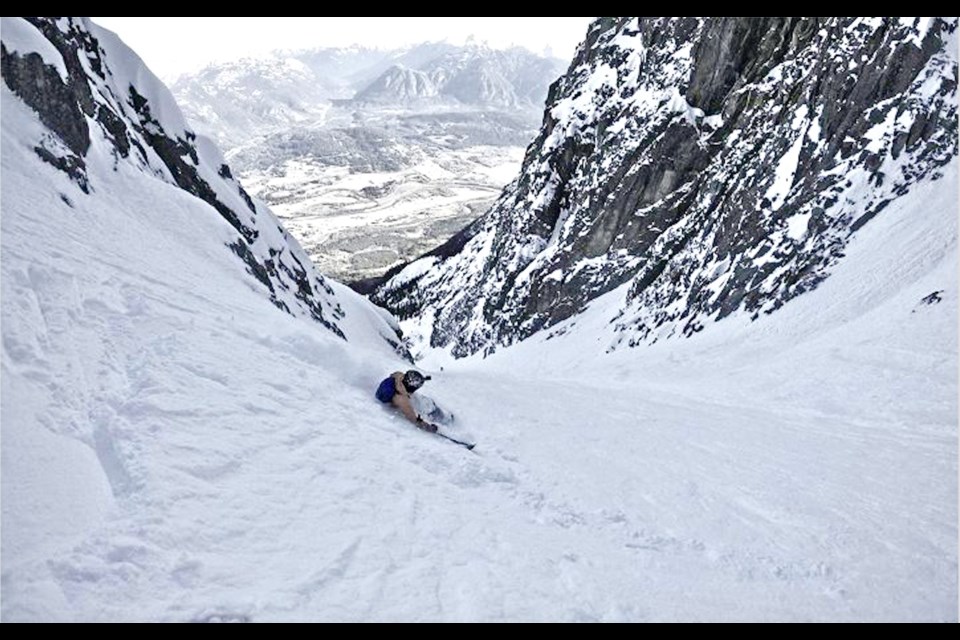A handful of “firsts” have already been shot down in the world of adaptive skiing. Like the first sit-ski backflip, landed by Josh Dueck in Whistler back in 2012, or the first-ever double-backflip, stuck this winter by Colorado’s Trevor Kennison, the same sit-skier who gained notoriety for airing into Corbet’s Couloir in Jackson, Wyo. a few years ago.
Squamish Paralympian Alex Cairns is fairly confident he can claim a few of his own. The former para-alpine athlete is among the first—if not the only—adaptive skiers to descend a score of Whistler’s gnarlier in- and out-of-bounds lines, like Blackcomb’s D.O.A. and Body Bag Bowl, while seated on a mono-ski. But those aren’t feats the 31-year-old is chasing—or even particularly proud of, for that matter.
“Everything in a sit-ski is a first right now, which is kind of hilarious,” he said.
“When you’re picking at low hanging fruit inside a resort, knowing that no one has sit-skied it before, it's fun to know you had to figure it out for your own skiing, but it doesn't change anything yet,” Cairns added. “I think the only reason you want to get a ‘first’ as a sit-skier is to change the perspective of able-bodied skiers … so they can understand where the sport is at and what we can do. That will open up a lot more doors.”
Justin Vadeboncoeur was standing near Blackcomb Mountain’s summit on April 4 when he spotted Cairns, his sister Kristina Cairns and friend Jimmy Martinello below, bootpacking up Disease Ridge before launching themselves down a steep face into Body Bag. Vadeboncoeur snapped a few photos and posted the shots to the Whistler Winter Facebook group, where they drew more than 700 likes and 70 comments. Many of those praised the crew’s feat as “inspirational.”
It's true the line was a new one for Cairns, but he is hesitant to accept the adulation, instead throwing all the credit to his sister and Martinello for offering to carry his equipment beyond the ski-area boundary and up the ridge. Cairns was born with spina bifida, a condition that manifested in paralysis at the two lowest vertebrae but left him with enough mobility to crutch around. The climb that would typically take an able-bodied skier about an hour took Cairns and co. closer to two, with Cairns making his way up using his outriggers as supports.
Even with the extra weight, “it wasn’t that far of a walk for us,” Cairns explained. “It was something we did, because we had time for it. The ski line isn’t that steep—it’s a pretty line, and it’s a lot of fun, but it’s kind of frustrating that the sport’s still in this position where a line like that blows people’s minds."
He added, "There’s a lot more in the tank, and a lot more we could have done in an afternoon off.”
There is, however, one line Cairns called “maybe the first" he's "proud to have been a part of.”
It happened in Pemberton, about a week prior to skiing Disease Ridge, when Cairns shredded down Mount Currie’s Diagonal Couloir alongside a crew including Martinello; Jon Burak, publisher and co-founder of Mountain Life Magazine; Valtteri Rantala and John Johnson, who Cairns estimates has skied the line on 15 occasions, give or take. A helicopter dropped the group on top of the peak, but it was up to them to make it out.
“That was definitely the first time I felt out there a little bit, even though you’re staring right into town,” said Cairns.
The route didn't offer up the dreamiest snow conditions that day, with “massive chunks of ice and debris” littered along some of the avalanche paths, but it was a fun excursion with incredible views, safe avalanche conditions and a knowledgeable crew Cairns credited with knowing the exact turns and the right calls to make in tough-to-navigate terrain, leading the crew back to the valley without any uphill travel.
“I can’t really ask for much more than that,” he said.
He estimates it took six hours from the helipad to reach the truck, with only half an hour of that spent walking.
For Cairns to successfully ski the kinds of lines he’s shredded this winter, he acknowledged he needs a team of safe, strong skiers who are on board "to carry an extra 40 pounds or the other ski or, take twice as long to get anywhere,” he said.
To have his friends and family so keen to support him in the mountains “blows my mind,” Cairns added.




